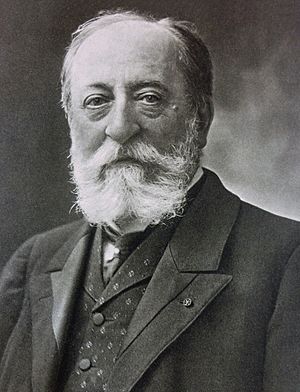Carnival of the Animals facts for kids
The Carnival of the Animals (in French: Le Carnavál de Animaûx) is a famous musical piece by Camille Saint-Saëns. It is one of the most well-known classical music pieces for children.
Contents
About The Carnival of the Animals
Camille Saint-Saëns wrote The Carnival of the Animals for fun. He was working on his Symphony No. 3 at the time. He first played Carnival for a small group of friends. Saint-Saëns did not want the public to hear it. He worried that people would think he only wrote silly music. He wanted to be known as a serious composer.
Only one part, the famous "Swan" movement for solo cello, was published while he was alive. The rest of the music was not played for everyone until a year after Saint-Saëns passed away. He wrote this piece in February 1894 in a small Austrian village. This was after a difficult concert tour in Germany.
What Instruments Are Used?
The Carnival of the Animals has 14 short parts, plus a short introduction. Saint-Saëns wrote it for a small group of instruments. These include a flute (which also plays piccolo), a clarinet, two pianos, a glass harmonica, a xylophone, two violins, a viola, a cello, and a double bass.
Today, it is often played by a full orchestra with many string instruments. A glockenspiel is often used instead of a glass harmonica. The glass harmonica is a very unusual instrument.
Exploring the Musical Animals
Each part of The Carnival of the Animals describes a different animal or group of animals. Saint-Saëns used different instruments and sounds to make each animal come alive!
- I: Introduction and Royal March of the Lion
This part starts with an introduction. Then, the pianos play a march that sounds like a lion roaring.
- II: Hens and Roosters
This music sounds like hens clucking. The strings make the clucking sounds. The clarinet plays a sound like a cock crowing.
- III: Wild Donkeys
The two pianos play very fast. They rush up and down the scales wildly. This sounds like wild donkeys running around.
- IV: Tortoise
This part is very slow. It is played by strings and piano, just like a slow tortoise. Saint-Saëns made a joke here. The tune is the famous "Can-Can" from Offenbach's Orpheus in the Underworld. But it is played very, very slowly!
- V: The Elephant
This part features the double bass and piano. The music makes the elephant sound heavy and clumsy. In the middle, the elephant tries to dance a waltz. This is another musical joke! The tune comes from other famous pieces.
- VI: Kangaroos
The two pianos hop around gracefully. This music sounds just like kangaroos jumping.
- VII: Aquarium
This is very graceful music. The flute plays the main tune. Strings play along. Sometimes, the glass harmonica makes sliding sounds called glissandi. It sounds like fish swimming in an aquarium.
- VIII: Persons with Long Ears
The "Persons with Long Ears" are actually donkeys. Two violins play sounds that copy the "hee-haw" of a donkey.
- IX: The Cuckoo in the Depths of the Woods
The pianos play soft chords. This sounds like someone walking quietly through a forest. Every now and then, the clarinet plays two notes. These notes sound just like a cuckoo bird calling.
- X: Aviary
The flute plays a very light and fast tune. Strings and pianos play with it. It sounds like birds flying around in an aviary (a large bird cage).
- XI: Pianists
This is another joke! "Pianists" are people who play the piano, not animals. Saint-Saëns makes them sound a bit silly. They are just practicing their scales over and over.
- XII: Fossils
The xylophone plays a fast tune. It sounds like skeletons dancing. Saint-Saëns made a joke about himself here. He used a tune from his own work, Danse Macabre. He also used parts of other old tunes, like "Twinkle Twinkle Little Star." He was saying these tunes were old-fashioned, like fossils.
- XIII: The Swan
This is one of the most famous tunes for the cello. It is a beautiful and smooth tune. It sounds like a swan swimming gracefully on water.
- XIV: Finale
All the instruments join in for the last part. The Finale includes bits and pieces from almost all the other movements.
Images for kids
See also
 In Spanish: El carnaval de los animales para niños
In Spanish: El carnaval de los animales para niños





